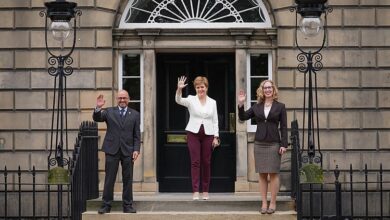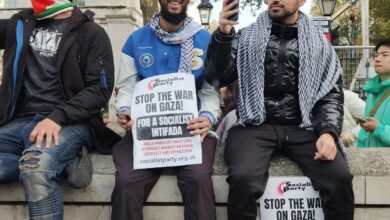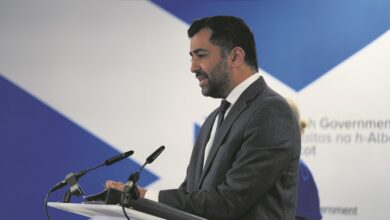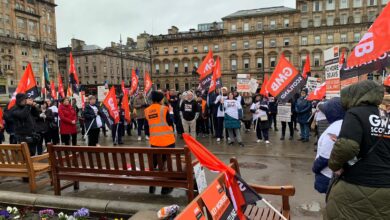Cuts politicians lose support in polarised council election campaign
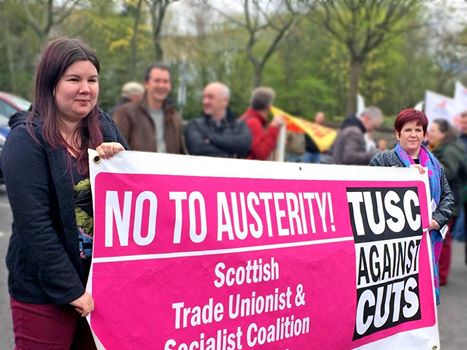
Philip Stott reports (updated on May 8th)
The 2017 Scottish council elections – conducted under the Single Transferable Vote proportional representation system – resulted in no party being able to form a majority administration in any of the 32 council areas.
Right wing Labour rejected
There was a significant rejection of those politicians who had carried out cuts. Right wing Labour were routed in the councils that they had controlled, Glasgow, North Lanarkshire and Renfrewshire among them. This was a direct result of having implemented huge cuts over the last few years. Labour also lost councillors in areas where they had been part of cuts-making coalitions, including Edinburgh, Aberdeen and Fife.
In all Labour lost a third of its council representation as their vote share fell from 31% in 2012 to just 20%, which underlines the decline in Labour’s support among working class communities in Scotland. The Tory gains in the election meant Labour were, yet again, relegated to third place, behind the SNP and the Tories.
SNP stall
Despite Nicola Sturgeon’s public statements that the SNP were the clear winners, the failure of the SNP to win majority control in Glasgow, or indeed any council in Scotland, will be a disappointment for them.
The SNP also lost their majorities on Dundee and Angus councils. Negotiations will now take place between parties over coalition deals or the formation of minority administrations in councils across Scotland.
The SNP share of the Scottish vote – 32.3% – was a significant drop compared to the 50% won in the 2015 general election landslide. The utter failure of the SNP to effectively oppose Tory cuts has led to a significant weakening of their support among the working class they have built their electoral success on.
The last time the council elections were contested was 2012, before the surge to the SNP that followed the 2014 indyref. Therefore the SNP might have been expected to have done better than only gaining a modest 6 councillors compared to 5 years ago. Nevertheless, they are the largest party in Scotland with 431 councillors and the biggest group in 16 of the 32 councils.
Most of the SNP gains were at the expense of Labour in those areas that Labour had been in charge, especially across the west of Scotland. But they also lost seats in areas where they were had been part of the ruling administrations and have been damaged by carrying out austerity cuts.
A Tory surge?
Much comment has been made in the press and across social media of the gains made by the Tories. Overall, the Tories more than doubled their numbers of councillors to 276, 22% of the Scottish total. The recent increases in Tory support has been overwhelmingly based on being seen as the most effective anti-SNP and anti-independence force. Reflecting this, the Ruth Davidson-led “Scottish Conservative and Unionist Party” campaign was almost exclusively based on opposition to a second independence referendum and support for the union. It was clearly an effective tactic, in particular among an older generation who voted against independence in 2014. As one Tory MSP commented: It’s people in their 60s voting Conservative for the first time. We’re hearing that from across the country.”
However, it’s worth pointing out that the gains made by the Tories were only possible through the STV system. This allows councillors to be elected with as little as 13% of the 1st preference votes, depending on transfers. Indeed in the Calton ward of Glasgow a Tory was elected with 11% first preference votes.
The limited Tory “surge” was evident in Glasgow where the Tories won only 8 councillors from a total of 85. In North Lanarkshire, with 77 council seats available, the Tories won 10. In Dundee the Tories hold only 3 of the 29 seats.
The famous case of “Tory elected in Ferguslie Park” in Paisley – there is no ward called Ferguslie Park – the Tory candidate won 13% of the vote and was elected after the 8th count.
Disastrously, Scottish Labour tried to compete with the Tories on the anti-independence ticket. Attempting to “out union the Tories” was always going to fail. Labour’s opposition to Scottish independence has been a decisive factor in their electoral decimation in Scotland, alongside their role in carrying out cuts.
Polarisation
The increasing polarisation around the national question in Scotland formed a key backdrop to the council election campaign. It was noticeable, for example, that anti-independence voters were mobilising to vote in large numbers. Turnout in the election was up significantly compared to 2012. The SNP leadership were also trying to shore up its falling support by using the national question and the “inevitability” of a May-led Tory victory. Of course this was added to by the announcement of a general election by Theresa May during the council campaign. For the final two weeks of the election campaign it was the national political debate that increasingly eclipsed any local issues.
Socialist campaign
Against this backdrop there was a squeezing of the space for candidates from the Scottish Trade Unionist and Socialist Coalition (TUSC) and other anti-cuts and left candidates, especially in the battle for 1st preference votes However, we were able to get a very friendly and positive response to our 100% anti-austerity and socialist campaign in Dundee, Glasgow, Renfrewshire, Ayrshire, West and East Lothian, where we stood 19 candidates in all, including13 Socialist Party Scotland members.
Dundee
The Dundee Against Cuts – TUSC campaign won 688 first preference votes for our seven candidates. This was an increase on the 488 votes polled in 2012. Very significantly, however, DAC-TUSC polled 3,878 1st, 2nd and 3rd preferences. The high number of 2nd and 3rd preferences showed a very strong identification with the 100% anti-austerity no cuts platform of the campaign from many working class people across the city.
There was an excellent 250 first preference votes (6.1%) for Stuart Fairweather, who is a local government worker and chair of the Dundee branch of Unite the Union. Stuart had stood as a TUSC candidate in the Maryfield by-election in 2016 when he won 5.1%.
Sinead Daly received 105 votes (1.7%) in Starthmartine and Leah Ganley 102 votes (1.8%) in Lochee.
Wayne Scott in Coldside, Leah Ganley in Lochee, Stuart Fairweather in Maryfield and Michael Taylor in North East all defeated the Lib Dem candidates. In addition 40,000 DAC-TUSC leaflets were distributed during the campaign making the case for no cuts budgets and for socialist policies to defeat austerity.
Glasgow
Scottish TUSC stood 7 candidates in Glasgow polling 457 1st preference votes. The SNP, who are now have 39 councillors in Glasgow, devoted a whole section of their manifesto to saying they would improve industrial relations in the city and work more positively in partnership with the trade unions. One example of this was promising to resolve the year-long dispute of the Unison janitors in an attempt to gain support from the council workforce.
The janitors will be the first group of workers to put the SNP to the test on their promises and it shows that a fighting, socialist trade union leadership has had a political impact in the city. This was also a key driver in Labour losing control of the council but the SNP will face the same issues if they continue to follow the strategy of implementing Tory cuts.
In the West of Scotland, our candidates participated in 10 hustings events and were very well received. TUSC polled the highest left vote in Renfrewshire and we stood the largest socialist challenge in Glasgow. Scottish TUSC candidates included young workers in Glasgow and Renfrewshire who’d never stood before.
Cathy Milligan, who stood as anti-austerity candidate calling for a no cuts budget position in the Castlemilk area, was very close to being elected for the Linn ward. Cathy polled 8.4% of the vote beating the 3rd SNP candidate. This shows the potential and openness to anti austerity left ideas. Scottish TUSC candidates also stood in North Ayrshire, East Lothian and West Lothian.
Fight goes on
What is clear is that the fight against cuts and the politicians who are implementing them will go on. Unison members who work for Scottish councils are balloting for strike action over pay. The next round of council cuts will put all councillors to the test. They have a choice, implement more Tory cuts or fight for no cuts budgets and for investment in jobs and services.
The impending general election campaign will give socialists another opportunity to raise fighting anti-austerity and socialist ideas. Socialist Party Scotland will be organising public meetings in all the areas that we stood candidates in for the council elections arguing that fighting socialist policies can defeat the Tories and capitalist-driven austerity.
Results for TUSC candidates highlighting 1st, 2nd and 3rd preference votes
Dundee
Sinead Daly – Strathmartine 1st 105 1.72% 2nd 224 3rd 501 Total (1,2,3) 830 13.6%
Leah Ganley – Lochee 1st 102 1.79% 2nd 112 3rd 293 Total 607 10.5% beat both Lib Dems
Wayne Scott – Coldside 1st 82 1.46% 2nd 113 3rd 235 Total 430 8.2% beat the Lib Dems
Stuart Fairweather – Maryfield 1st 250 6.1% 2nd 222 3rd 445 Total 917 25% beat both Lib Dems
Michael Taylor – North East 1st 52 1.36% 2nd 101 3rd 196 Total 349 12.3% beat the Lib Dems
Ian McKay – East End 1st 54 1.2% 2nd 174 3rd 220 Total 448 11.1%
Paul Johnson – Ferry 1st 43 0.48% 2nd 101 3rd 153 Total 297 3.3%
Glasgow
Ward 3, Greater Pollok (10 Candidates), Mark McGowan, 77 1st prefs, 0.9% 101 2nd, 347 third. Total 525 6.1%.
Ward 7, Langside, (Nine Candidates) Ronnie Stevenson, 97 1st Prefs, 0.9% 184 2nd, 446 third Total 727 6.7%
Ward 12, Victoria Park, (Seven Candidates) Matt McGrath, 52 1st Prefs, 0.6% 228 2nd Prefs, 306 3rd Prefs, Total 586 6.8%
Ward 16, Canal, (Eleven Candidates) Angela McCormick, 62 1st Prefs, 1,07%, 121 2nd, 236 3rd. Total 419 7.2%
Ward 17 Springburn and Robroyston (Ten candidates) Dave Semple, 36 1st Prefs, 0.5%, 61 2nd, 208 third. Total 305 4.6%
Ward 18 East Centre (Nine Candidates) Matt Dobson, 80 1st prefs 1,13%, 125 2nd, 316 third. Total 512 7.3%
Ward 19 Shettleston (12 Candidates) Jamie Cocozza, 80 1st Prefs 1,1%, 97 2nd, 148 3rd, 331 4.3%.
East Lothian
Jimmy Haddow – Tranent, Wallford and Macmerry
1st 63 1% 2nd 75 3rd 301 Total 439 7%
West Lothian
Elaine Mallon – Broxburn, Uphall and Wichburgh
1st 57 2nd 117 3rd 178 Total 352 5%
North Ayrshire
Ian Kerr – Irvine South
1st 42 1.2% 2nd 62 3rd 250 Total 354 10.5%
